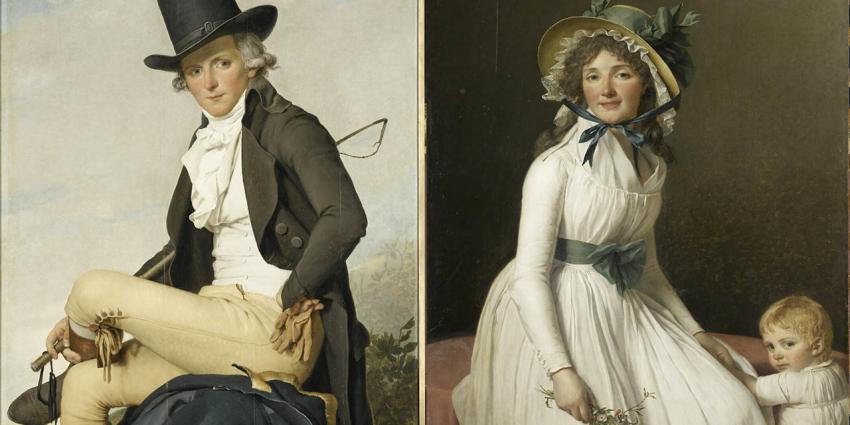FRENCH WOMEN FASHION
FRENCH WOMEN FASHION TRENDS IN THE 18TH CENTURY
Preface - In this brief papers I wanna show what were the women's fashion trends in the 18th century. Mostly I produce law cases, but here I wanna shown how gone were the days of ornate, heavy dresses with lots of layers and embellishments. Instead, women opted for lighter fabrics in solid colors that showed off their natural curves. One popular style was the chemise a la reine, which featured a fitted bodice and full skirt. This look was often accessorized with a delicate scarf or shawl. Another popular option was the robe à la française, which consisted of a fitted bodice and wide skirt that hung down to the ground. This style was often worn with a petticoat for added volume.
The 18th century is a period where fashion and especially makeup and cosmetics were widely used by women to emphasize the enlightenment of French revolution. Fashion styles change and depend on the country of origin; in France, this period was characterised by attention to hair style and makeup among young women. England was also part of the fashion giants during this era even though not to the extent as France was. Sense of fashion in his era was characterized by what women wore in the studios. However, hairstyles and makeup did not differ depending on events and/or social gatherings. The 17th and the 18th centuries were highly dominated by the French fashion where women dressed and displayed their beauty in front of a selected audience. The canon of beauty favoured women with wavy brown, blond or black hair, which is clearly seen on French portraits of the 18th century, where it is very rare to find a woman with red hair.
This essay explores different fashion and hairstyles, and the matching accessories of the 18th in France and England. It also looks at the fabrics and the patterns used in making the dresses. The essay provides a comparison of English and French fashion trends and defines common elements of style for both countries. Development of different plates and prints in the period from the 17th to the 19th century is also analyzed in order to make comparisons of the common trends used in this era
The evening dress was a common fashion style in France in the Regency and the Napoleonic era. The dress had its own unique sewing patterns that made the dresses fit for evening occasions. Dresses were matched with hairstyles, cosmetics and accessories. Styles were named differently depending on the country of origin with Regency being the fashion style adapted in England and Napoleonic being the common French fashion style. Evening dress with high waistline was a common fashion dress during this century. Evening dresses of that period are characterized with the silhouette where the waistline was always just some inches below the bust. Changes in the waistline line were minor as it drifted a few inches below the bust over time, but the waistline was never too far from the bust. The neckline was always left open as seen in most of the plates from this era. The exact shapes of the neckline varied depending on the fashion style or the season when the dress was to be worn. Some of the most common variations of the neckline included the square neck that was not very low-cut and had an inward angle towards the shoulders. This neckline was very narrow. The other common variation was the wide scoop neckline that showed a part of the chemise worn inside or a part of the dress. Wide v-neck variation was also a common trend in dresses worn during this era. Another common variation was the wide square variation neckline.
The bodice, on the other hand, had an opening in the back where drawstrings were tied to the waistline and the neckline to make the dress look unique. The arrangement of the strings was unique for the dress and was made depending on the preference of the owner. The bib-style, common for the dresses, was attached to the under bodice at the back or to a v-neck of the dress. Women wearing low cut bodice that were not as conservative as we could assume are another common characteristic of the fashion era during the 16th - 19th centuries. Most women wore low cut bodice exposing most of their bosom. However, it was not acceptable to wear bodice that exposed too much shoulders and back. There are portraits of women exposing one or both nipples in many occasions even though they might act surprised, this was a common occurrence in any ball or event. Women who were bold enough to expose their nipples were seen as outgoing while those who were not daring enough just allowed their areolas to show in their low cut bodice.
The sleeves of the silhouette were short with slight puffs. Though, the sleeves were mostly made to reach the elbow, some outfits also had long sleeves. The skirt of the evening dress was mostly flat with some tucks at the back. Others were slightly gathered at the front part and the length of the hems varied depending on the season or occasion. The hems varied in length especially for the dancing dresses that came in different lengths. The fabrics used to make the silhouette dresses was mostly white silk or linen. White was a common color during this era. It was very fashionable when white embroidery was done on a white fabric as it made the woman unique and reflected on an inner beauty. The other fashionable colors used on fabrics were the light sheer overdresses that had colorful embroidery in the front part made of silk over a satin tucks. The colors were always contrasting to bring out the color in the embroidery. There were trims evident in the necklines of the dresses with some having trims on the sleeves, waist and the front part of the outfit.
Silhouettes were not complete without undergarments. One had to have the correct undergarments to support the dresses in order to create the right impression. The era did not mark disappearance of the chemise and petticoats as most believe. The chemise or the shift was very simple with an opening that was either square at the neckline and some had back strings. The chemise was mostly short sleeved and the fabrics were cotton or linen. It was worn inside a corset to keep it clean and act as a protection to the body. The need for a high waist silhouette forced women to wear corsets. Corset acted as a support to a woman’s natural curves by providing a soft support to the busts. It has straps on to be tied around the neck or in the shoulders to keep it place. Just like the chemises the fabrics used and the lengths varies depending on the season. However, cotton corsets were common during this era.
The petticoats worn during the silhouette era had straps on to keep them at the high waist. However, some were attached to the dresses through the bodice and followed the flow of the dress worn. Drawers and pantaloons during were not commonly worn as compared to corsets and chemises. One could spot a lady with small bustle pads that were attached to the dress at the back side of the waist to help keep the skirt in place.
The most commonly worn accessories included gloves, shoes, stockings, pockets, reticules, pelisse and spencer’s. The commonly worn color when it came to shoes, gloves and stockings was white. However, as fashion changed, this color was later replaced by other bold colors. Stockings were cotton silk or in other cases opaque with ribbon decorations or rosettes.
Pockets were attached to the inner side of the dress. However, this was not seen as a fashionable trend and they were eventually substituted by reticules. Reticules were carried to help the user keep the indispensible items safe. A pelisse is one of the outdoor garments that played the same role as the coat. Some had sleeves while others did not. They were worn over a dress with the most common lengths being the three quarter with an opening on the front part. Shawls and cloaks were placed over the shoulders especially during outdoor events.
Hairstyles
There was a variety of hairstyles used in this fashion era. Some of the common hairstyles seen in plates form the century show that women had their hair piled on top of their heads forming a huge bulk. This was imitation of the Greek sculptures where women had their hair folded on top of their heads. In some cases women set their hair at the back of the head with a ban. Rings on the forehead were a common fashion in this era.
One other common fashion trend for women during this ear was powdering of hair to suit the fashion demand at the time. Most of the powders used to dye hair in dark colors as dark hair was considered fashionable. This practice was also common among men.
Another fashion trend of the era was wearing of wigs by men. This began with the sudden balding of King Louis XIII of France when he was just 23 years old. He had kept his hair long and sudden loss of his hair led to a new fashion style for men who picked up the wig to condone their lack of hair. Women were never seen wearing wigs as their fashion sense was based on unique hairstyles and headgears that matched their dresses.
Headdresses were a common feature during this era and women wore them to complete a hairstyle. Some common headdresses included bandeaus that had a circlet made from gold or pearls; bandeaus were used to match the fabrics of a dress. Other common headdresses were made from ribbons or bands with jewels. Turbans with circlets made from flowers were a common trend when it came to head gear. However, one can also note from the plates that ostrich feathers were used to complete the headgear.
Some of the jewelry worn during this era included simple necklaces made of pearl or beads. Classical earrings made from cameos were a perfect match to finish the ensemble.
One of the common fashion trends borrowed from England by the French fashionists was having small curls of hair at the back of the head. This was later picked up by the French women who modified it to suit their dresses by using a band or braiding it into a knot at the back of their heads.
Cosmetics used during this era included red makeup applied on the lips, the eyes and the eyebrows. The red makeups were made from grounded cinnabar with mercury. Others were made from exposing vinegar to lead plates. They were then mixed with grease to create paste that would then be applied on the face. Use of cosmetics was mostly common among actors and women form the upper class in the society. The women had their cheeks dabbed to ensure that the skin whitened to make the red cosmetics used on the eyes and lips clearly seen.
Conclusion
It is clear that the fashion styles in France and England were similar with both countries borrowing beauty tips from each other. Women in this era were keen on their looks and most of them wore dresses with bodice and chemises. Dresses of the era are characterized by low cut bodice. Women ensured they completed their look with accessories and headgears that helped match the look and the fabrics used in their dresses. Plates and prints form this era show that women were keen on maintaining a pretty look with minimal use of cosmetics, which appeared in the fashion industry later on in the century. Use of make-up was initially common among actresses even though this changed over time as those from the middle or lower classes adapted to the trend.



